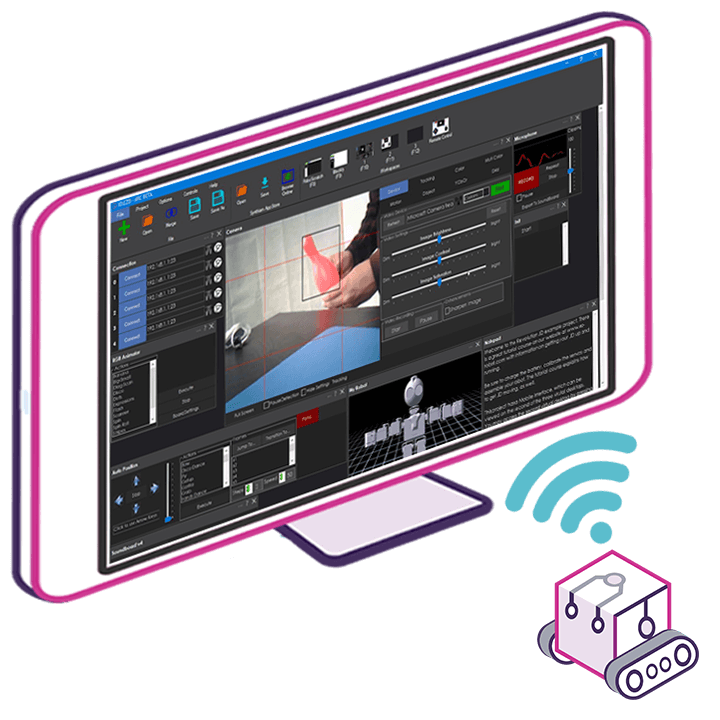castlephelps
USA
Asked
— Edited
Thanks to everyone for helping me get up and going! I've learned how to connect hardware, download projects and learning ez scripting. I have never been one to reinvent the wheel so here goes....
I am looking to build a robot that will steer using polar coordinates. Is there an easy way to do this?
Castle

@Richard R here is one on eBay in from a UK seller http://www.ebay.com/itm/Dual-axis-Magnetic-Sensor-Module-UART-I-2-c-Interface-/230643656408
There are probably plenty of choices now that we have UART, but they would all require scripting just to get the data, where this one has a control built in.
For iPhone, it communicates over Wifi. You put the SensorStream app on it, and then in the Misc controls, add a iPhone Sensor Stream Server object, and it creates a bunch of variables for everything the iPhone can detect. I don't use it. I have asked DJ to please create an object for one of the many Android sensor stream type apps available, but it is low on his priority list (if on it at all). The developer of Sensor Stream doesn't make an Android version of the app, but there are half a dozen similar for Android.
@castlephelps Richard is right, your robot needs to have something to compare to in order to give a specific offset direction. the other way to do it is with encoders on your wheel motors so it always knows how far each wheel has spun and can calculate from there, but that is imperfect since wheels can slip on different surfaces. Compass is the easiest solution (GPS doesn't well work inside and doesn't give direction if you are moving at less than 1km/hour).
Oh... I was typing while you were answering.
Servos (other than 360 rotation servos) are easy because they move to specific positions. You can use relative servos or actions and frames to achieve what you want. Very easy to move to specific points in space using preprogrammed actions.
Alan
@Castlephelps... You can do this easily if you're ok with just "relative" position... A good quality servo can swing 90 degrees in either direction in 1 deg increments... For "absolute" position you will need something like a magnetic compass (maybe two, one for each arm) I think the one Alan mentioned would work... Either way, the ezb can do the math no problem...
@Alan, thanks for the link...
Definitely! I am looking for relative positioning. My robot is going to sit in the middle of the room, bolted down - I am not navigating across any surfaces. But I want the robot arm to be able to reach anywhere in the room - so I am looking as rotation and extension - probably with an arm with an elbow - all done with non 360 degree rotation servos.
Take a look at this project that uses all auto-position frames. (and EZ-Bits, but could be done with any servo controlled arm).
https://synthiam.com/Community/Questions/6844
Alan
So, imagine a stationary robot in the middle of the room. I want to eventually be able to have the arm with a camera to be able to search the entire room for an object and then pick up that object from the floor and put it on a shelf in the room. I want it to pick up my tools and put them away when I finish in the room basically... I think that this will take polar coordinate positioning to have the arm travel in a search pattern covering the entire floor. When it finds a tool, it interrupts the search pattern, picks up the tool, puts it in a specific place on a shelf (this would take object recognition and then database look up) and then returns to where it was in the search and continues picking up tools and putting them away until the entire floor is covered.
I get what you are trying to do. Pointing in the direction of the functions that will get you there. Multiple auto-positions that are executed based on what the camera sees are going to be the solution.
@bhouston is working on a similar concept (on a smaller scale) so you might get some inspiration from this thread too: https://synthiam.com/Community/Questions/6909
Alan
Interesting - I need to learn more about auto-positioning. The thread you provided is very inspirational. But I am thinking more about executing a search pattern with the camera on the end of the arm searching for objects and then picking them up and putting them away. I am considering using RFID tags on the tools for identification and put away location. It is the execution of the systematic search of the room with the arm a given distance from the floor over the entire floor looking for tools with RFID tags that I am currently interested in.